Comments / Questions (13)
![]() Mette wrote:
Mette wrote:
Jeg skal til at strikke bagstykket. Min omgangsstart er i midten af det stykke. Hvornår skal jeg starte indtagningerne, og hvor bliver min nye omgangsstart? Hvis jeg flytter min markør, kommer det første halve stykke jo en omgang foran. Håber mit spørgsmål giver mening.
14.05.2025 - 21:39DROPS Design answered:
Hej Mette, du kan gøre det at du strikker frem til den nye omgangsstart, det kan ikke ses om det først halve stykke er en pind foran :)
20.05.2025 - 14:44
![]() Alejandra wrote:
Alejandra wrote:
Can a girl wear this?
17.03.2025 - 17:28DROPS Design answered:
Dear Alejandra, sure, why not? You will find more vest patterns here if you like to get a larger choice. Happy knitting!
18.03.2025 - 09:49
![]() Sue Dillon-Thiselton wrote:
Sue Dillon-Thiselton wrote:
Please can you help. After the decrease for the armholes the pattern is unclear. The patterns says work on each part separately and then gives a = sign? I am afraid I do not understand this. Please can you help. FYI I am knitting on ordinary needles. Many thanks.
26.01.2024 - 20:36DROPS Design answered:
Dear Mrs Dillon-Thiselton, after you have cast off the stitches for armhole, you slip the stitches on front piece on a thread/another needle and work now the stitches on back piece only, ie the 46 (50-56-60-64-68-72) stitches (see size) on needle. Happy knitting!
29.01.2024 - 11:31
![]() Elise Christine Fradet-Farago wrote:
Elise Christine Fradet-Farago wrote:
"Strikk vrangbord (= 2 rett/ 2 vrang) i ca 5 cm (inkludert brettekant). " - betyr det da 10cm? Så det er 5cm halskant når den er bretta og sydd fast på baksiden ?
29.12.2023 - 13:32DROPS Design answered:
Hej Elise, Vrangborden är bara 2,5 cm :)
03.01.2024 - 08:15
![]() Malin wrote:
Malin wrote:
Heisann! Når har jeg kommet til ermhullet og lurer på hva jeg skal gjøre med fortykket mens jeg strikker bakstykke😄 Hadde vært fint om det sto i oppskriften, ser at det mangler i flere av oppskriftene deres, så jeg blir ikke riktig klok!🤣 Takk for svar!
13.11.2023 - 20:31DROPS Design answered:
Hei Malin, Masker du ikke strikker kan settes på en hjelpepinne (ekstra pinne). God fornøyelse!
14.11.2023 - 06:52
![]() Sylwia wrote:
Sylwia wrote:
Kupiłam na tę kamizelkę włóczkę Baby Alpaca Silk. Na włóczce polecane druty to 3,5mm. Jaką ilość oczek powinnam użyć na kamizelkę w rozmiarze 12/18 miesięcy?
24.10.2023 - 11:56DROPS Design answered:
Witaj Sylwio, musisz wybrać kamizelkę, która jest wykonana z włóczki z grupy włóczek A, do tej grupy należy Baby Alpaca Silk. Możesz wziąć za przykład kamizelkę o numerze Children 28-3. Do dzieła :) Pozdrawiamy!
24.10.2023 - 13:04
![]() Patricia Fuchs wrote:
Patricia Fuchs wrote:
Danke für Ihre Antwort, nun tut sich noch folgende Frage auf: Wenn ich die Schultern mit einem 3-needle-bind-off schließen möchte, ende ich da mit einer Hinreihe oder Rückreihe? Ist das für linke und rechte Schulter bzw. Vorder- und Rückenteil anders? Sorry und herzlichen Dank!
05.05.2023 - 12:49DROPS Design answered:
Liebe Frau Fuchs, die letzte Reihe ist nicht nötig, ob sie eine Hin- oder Rückreihe ist, aber wenn Sie diese 3-Needle-Bind-off sichtbar möchten, soll diese eine Hin-Reihe sein, sollte sie unsichtbar, dann soll es eine Rück-Reihe sein - wie in unserem Video. Viel Spaß beim stricken!
05.05.2023 - 13:11
![]() Patricia Olivia Fuchs wrote:
Patricia Olivia Fuchs wrote:
Hallo, Team. Frage zu Rückenteil, Armloch abketten " In der ersten Hin-Reihe je 1 Masche nach den ersten und vor den letzten 2 Maschen, d.h. beidseitig, abnehmen". Wie stricken sie denn die erste und letzte Masche? Das gibt so einen hässlichen Rand - verschwindet der dann beim Auffassen der Maschen aus dem Seitenrand? Machen Sie einen Knötchenrand oder was anderes? Vielen Dank.
03.05.2023 - 18:58DROPS Design answered:
Liebe Frau Fuchs, die Randmaschen stricken Sie, entweder glatt rechts oder Krausrechts, wie Sie möchten; beim Auffassen sieht man diese Maschen dann nichts mehr. Der Rand sollte aber ganz normal aussehen, dh wie ein Strickstück glatt rechts gestrickt. Viel Spaß beim stricken!
04.05.2023 - 08:04
![]() Victoria wrote:
Victoria wrote:
Hej Jeg har lige lukket af til ærmegab og skal til at strikke frem og tilbage på mit bagstykke, men min omgangsstart er jo midt i bagstykket, hvordan skal jeg strikke frem og tilbage uden det bliver skævt?
14.12.2022 - 13:23DROPS Design answered:
Hej Victoria, du fortsætter frem og tilbage forbi omgangsstarten :)
15.12.2022 - 09:23
![]() Else Johansen Panagiotaki wrote:
Else Johansen Panagiotaki wrote:
Hei Hvis dette er en oppskrift som er gjennomgått i alle størrelser, hvorfor ikke oppgi hvor mange masker man må plukke opp til halskant i hver størrelse? I oppskriften oppgir dere et margin fra 60 - 96 masker og at man må prøve seg frem til hva som passer
29.10.2022 - 08:03DROPS Design answered:
Hei Else. Ved å plukke 60-96masker vil du kunne tilpasse det maskeantallet som passer ditt plagg best slik at man ikke blir helt låst om man mangler 1 maske eller 3. Men strikker du den minste str vil 60 masker passe fint og ved den største størrelsene passer 96 masker best, og da er det ikke så vanskelig å finne ut hvilken maskeantall på de andre størrelsene når maskeantallet må være delbart med 4. mvh DROPS Design
31.10.2022 - 11:18
Gledesspreder#gledesspredervest |
|
 |
 |
Knitted vest for baby and kids in DROPS Karisma. Piece is knitted in stockinette stitch with double neck edge. Size 12 month - 12 years
DROPS Baby & Children 38-8 |
|
|
------------------------------------------------------- EXPLANATION FOR THE PATTERN: ------------------------------------------------------- DECREASE TIP-1 (evenly): To calculate how to decrease evenly, use the total number of stitches on row (e.g. 120 stitches) and divide stitches by number of decreases to be done (e.g. 12) = 10. In this example decrease by knitting every 9th and 10th stitch together. DECREASE TIP-2 (applies to decrease for armholes and neck): All decreases are done on a row from right side! Decrease 1 stitch at the beginning of row as follows: Knit 2, slip 1 stitch knitwise, knit 1, pass slipped stitch over (= 1 stitch decreased). Decrease 1 stitch at end of row as follows: Work until 4 stitches remain, knit the next 2 stitches together (= 1 stitch decreased), knit 2. BIND-OFF TIP: To avoid a tight bind-off edge you may use a larger needle size. If this also is too tight, work a 1 yarn over after approx. every 4th stitch while binding off (bind off yarn overs as regular stitches). ------------------------------------------------------- START THE PIECE HERE: ------------------------------------------------------- VEST - SHORT OVERVIEW OF THE PIECE: Worked in the round on circular needle from the bottom and up to armhole, then work front and back piece back and forth separately. Work an edge around the sleeves and in the neck in rib at the end. BODY: Cast on 120 (128-140-148-156-164-172) stitches on circular needle size 3 MM = US 2.5 with Karisma. Knit 1 round. Then work rib (= knit 2/purl 2) for 4 cm = 2". Switch to circular needle size 4 MM = US 6, knit 1 round while decreasing 12 stitches evenly– read DECREASE TIP-1 = 108 (116-128-136-144-152-160) stitches. Work in stockinette stitch in the round. REMEMBER THE KNITTING GAUGE! When piece measures 22 (24-27-30-33-36-39) cm = 8¾" (9½"-10⅝"-11¾"-13"-14¼"-15¼") from cast-on edge, bind off stitches for armholes as follows: Knit 23 (25-28-30-32-34-36) (= half back piece), bind off the next 8 stitches, knit 46 (50-56-60-64-68-72) (= front piece), bind off the next 8 stitches and knit the last 23 (25-28-30-32-34-36) (= half back piece). Now finish each part separately. BACK PIECE: = 46 (50-56-60-64-68-72) stitches. Work in stockinette stitch back and forth. On first row from right side decrease 1 stitch inside 2 stitches in each side of piece - read DECREASE TIP-2! Decrease like this on every row from right side 3 (2-3-3-4-3-3) times in total = 40 (46-50-54-56-62-66) stitches. When piece measures 30 (33-37-41-45-49-53) cm = 11¾" (13"-14½"-16⅛"-17¾"-19¼"-21") from cast-on edge, bind off the middle 26 (28-30-32-34-34-36) stitches for neck (= 7 (9-10-11-11-14-15) stitches remain on each shoulder) and finish each shoulder separately. Decrease 1 stitch inside 2 stitches on next row from neck = 6 (8-9-10-10-13-14) stitches. Bind off when piece measures 33 (36-40-44-48-52-56) cm = 13" (14¼"-15¾"-17¼"-19"-20½"-22") from cast-on edge. FRONT PIECE: = 46 (50-56-60-64-68-72) stitches. Work in stockinette stitch back and forth. On first row from right side decrease 1 stitch inside 2 stitches in each side of piece - read DECREASE TIP-2! Decrease like this on every row from right side 3 (2-3-3-4-3-3) times in total = 40 (46-50-54-56-62-66) stitches. When piece measures 27 (30-33-37-40-44-47) cm = 10⅝" (11¾"-13"-14½"-15¾"-17¼"-18½") from cast-on edge, bind off the middle 20 (22-24-26-28-28-30) stitches for neck (= 10 (12-13-14-14-17-18) stitches remain on each shoulder) and finish each shoulder separately. Decrease 1 stitch inside 2 stitches towards the neck 4 times in total= 6 (8-9-10-10-13-14) stitches. Bind off when piece measures 33 (36-40-44-48-52-56) cm = 13" (14¼"-15¾"-17¼"-19"-20½"-22") from cast-on edge (adjust according to back piece). ASSEMBLY: Sew the shoulder seams. NECK EDGE: Pick up 60 to 96 stitches along neck edge inside 1 stitch from right side on double pointed needles size 3 MM = US 2.5 with Karisma (adjust so that number of stitches is divisible by 4). Note that the edge around the neck should not be tight or loose, pick if needed up more/fewer stitches. Work rib (= knit 2/purl 2) for approx. 5 cm = 2" (including folding edge). Bind off with knit over knit and purl over purl - read BIND-OFF TIP. Fold the edge double and fasten it where stitches were picked up for neck edge on the wrong side, avoid a tight seam. SLEEVE EDGE: Pick up 48 to 72 stitches along sleeve edge inside 1 stitch from right side on double pointed needles size 3 MM = US 2.5 with Karisma (adjust so that number of stitches is divisible by 4). Note that the edge around the sleeve should not be tight or loose, pick if needed up more/fewer stitches. Work rib (= knit 2/purl 2) for approx. 2 cm = ¾". Bind off with knit over knit and purl over purl - remember BIND-OFF TIP. Work the other sleeve edge the same way. |
|
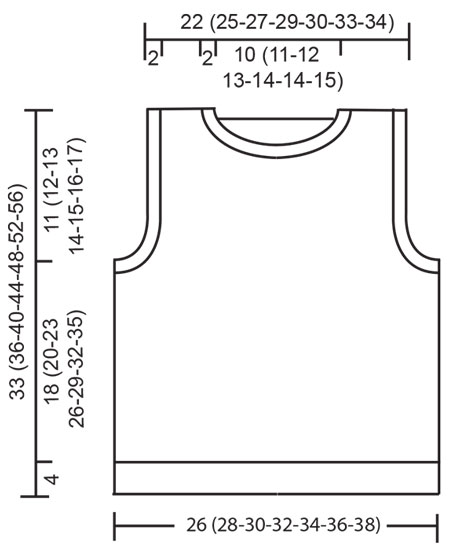
|
|
Have you finished this pattern?Tag your pictures with #dropspattern #gledesspredervest or submit them to the #dropsfan gallery. Do you need help with this pattern?You'll find 23 tutorial videos, a Comments/Questions area and more by visiting the pattern on garnstudio.com. © 1982-2025 DROPS Design A/S. We reserve all rights. This document, including all its sub-sections, has copyrights. Read more about what you can do with our patterns at the bottom of each pattern on our site. |
|







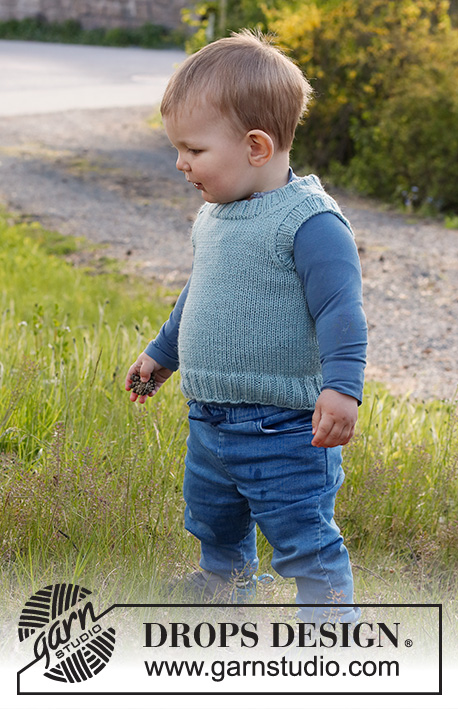
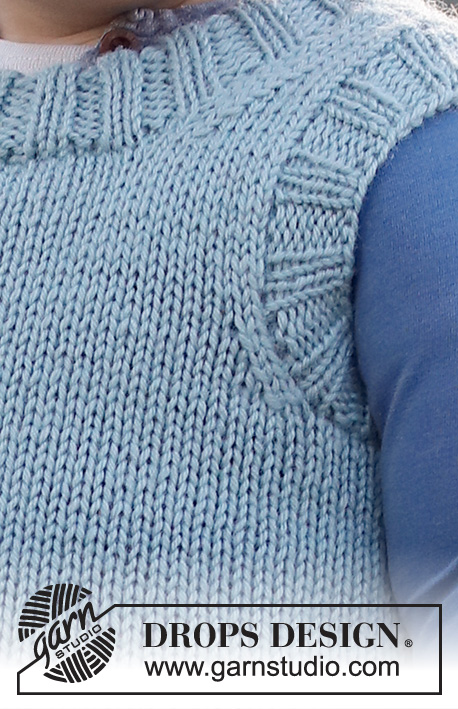



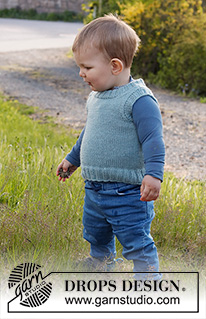
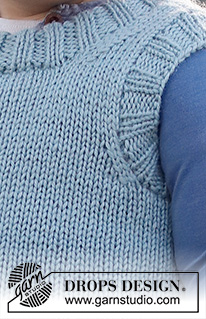
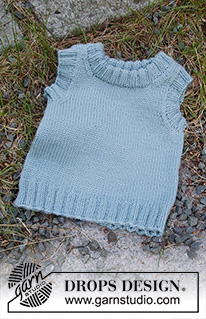













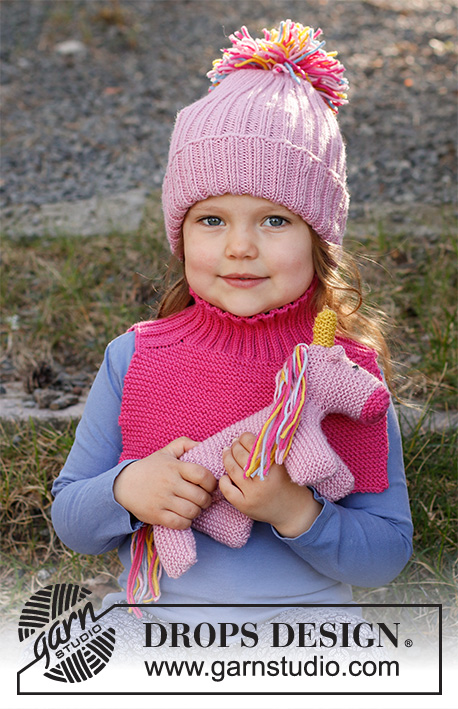











































Post a comment to pattern DROPS Baby & Children 38-8
We would love to hear what you have to say about this pattern!
If you want to leave a question, please make sure you select the correct category in the form below, to speed up the answering process. Required fields are marked *.